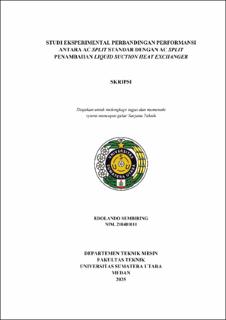Studi Eksperimental Perbandingan Performansi antara AC Split Standar dengan AC Split Penambahan Liquid Suction Heat Exchanger
An Experimental Performance Comparison of a Split Air Conditioner With and Without a Liquid Suction Heat Exchanger

Date
2025Author
Sembiring, Edolando
Advisor(s)
Sitorus, Tulus Burhanuddin
Metadata
Show full item recordAbstract
The use of a heat exchanger in a cooling system is a method to improve the efficiency of an air conditioner. A liquid-suction heat exchanger (LSHE) is added to prevent wet compression by ensuring the refrigerant enters the compressor as a superheated vapor rather than a saturated vapor. This is achieved by installing the LSHE to facilitate heat exchange between the hot liquid refrigerant from the condenser outlet and the cold vapor refrigerant from the evaporator outlet. The experiment was conducted for 6 hours, with data recorded every 10 minutes. Pressure was measured at the evaporator outlet (suction line) and the compressor outlet (discharge line). Temperatures were recorded at six key points: the compressor outlet, condenser outlet, expansion valve outlet, evaporator outlet, and on the liquid and suction lines after the LSHE. The results showed that implementing an LSHE with R410A refrigerant led to a 29,63% increase in the Coefficient of Performance (COP), a 8,02% increase in the refrigeration effect, a 16.53% decrease in compressor work, and a 12.94% saving in electrical power consumption. Similarly, for R290 refrigerant, the LSHE resulted in a 44,25% increase in COP, a 7,97% increase in the refrigeration effect, a 25,12% decrease in compressor work, and an 18.28% saving in electrical power consumption.
Collections
- Undergraduate Theses [975]
